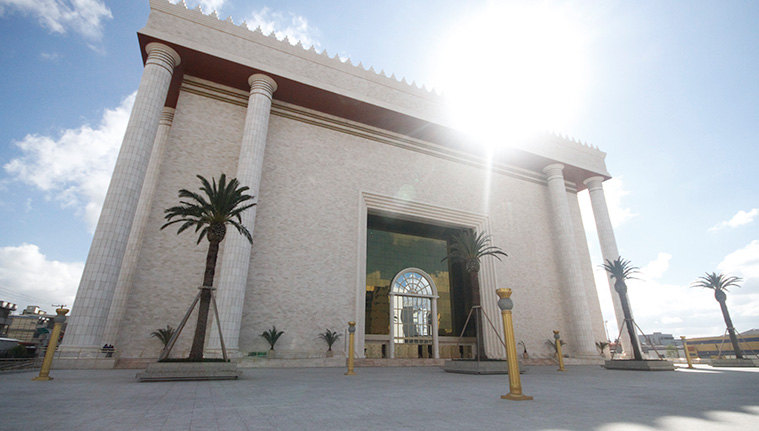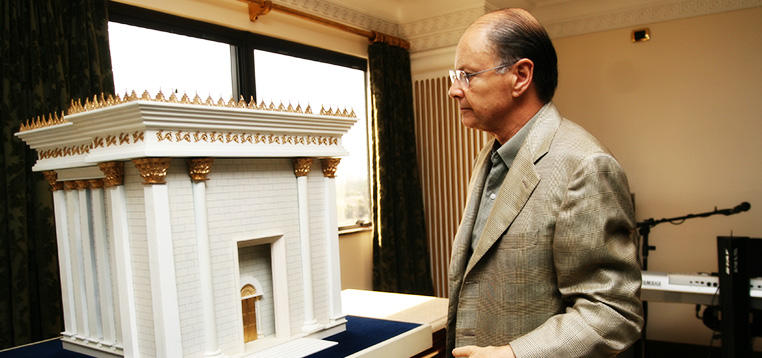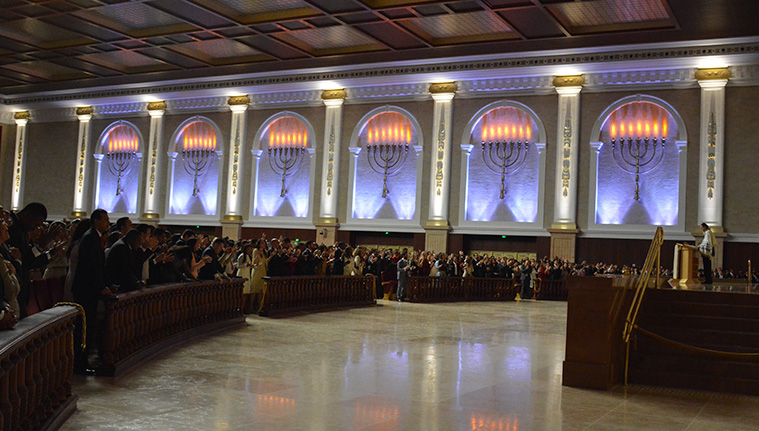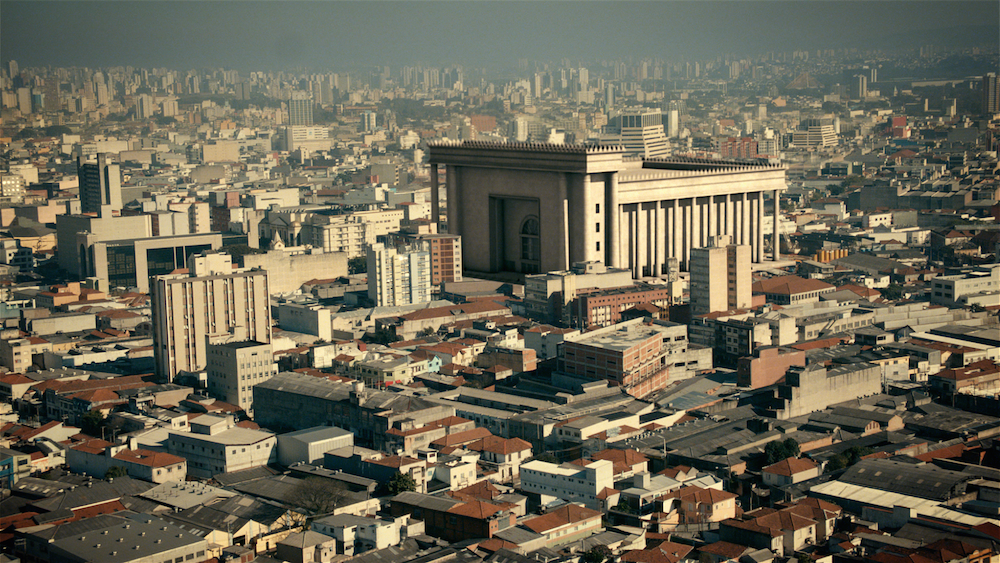When the Queen of Sheba travels to Jerusalem intent on wresting power from King Solomon in the 1959 Hollywood classic Solomon and Sheba, Solomon, played by Yul Brynner, can’t help but stray from Yehova’s law and fall in love with her—in the form of a radiant Gina Lollobrigida.1 As punishment, God discharges some rudimentary lightning, breaking apart the presumably stone—though more likely papier-mâché—temple.

If Solomon’s first temple was, in fact, demolished by Nebuchadnezzar II after the siege of Jerusalem of 587 B.C., as it’s described in the Old Testament, it matters little for the film. The temple’s destructions and reconstructions began long ago and have yet to end. When the Jews returned from Babylonian captivity around 516 B.C., a second temple was erected on the Temple Mount, only to be looted later and its religious services stopped until its massive expansion by King Herod circa 20 B.C. Roman legions perpetrated yet another burning and shattering of Herod’s Temple in 70 A.D. Since then, Jews have prayed for its rebuilding—something that will take place, as stated by Jewish theology, with the advent of the Messiah.2 Though otherworldly visions had been drawn for this coming of the third Temple, somehow the Pentecostal Universal Church of the Kingdom of God (UCKG) has won the race, recently completing a 55-meter-high version of dubious taste in São Paulo, Brazil.

Allegedly five times the area of Saint Peter’s Basilica and with its main façade plated in Israeli stone, this eisegesis of Solomon’s Temple, beset with controversy, soars next to the city center. Explaining the leap in scale between the source and the latest version, architect Rogério Silva de Araújo, author of the project, declared, “We made a larger project in reference to the passage of Haggai, Chapter 2.9, which says, ‘The glory of this latter house shall be greater than the one of the former.’”3 The fact that it resembles Herod’s second temple considerably more than it does Solomon’s first—perhaps because more images and 3-D models were available to researchers—does not seem to bother the estimated 12 million worshippers of the UCKG, who are spread throughout 100 countries.4
Nor do the suspiciously oblique maneuvers that led to its construction seem to weaken the support of the congregation. As reported by the main local newspaper, Folha de São Paulo, the Universal Church used false information to circumvent local laws and thus build its reportedly 74,000-square-meter sumptuous headquarters for $270 million. Since the land acquired by the church is located in a special area of social concern, any new building above 500 square meters that requires the demolition of an existing structure compels the allocation of at least 40 percent of the land to affordable housing.5 But, since in cases of renovation there is no such legal requirement, in 2006 the church sought and obtained permission to renovate a building that had already been demolished at least two years earlier. It is heartwarming to imagine how the temple might look if its owners were required to convert 40 percent of its volume into social housing. For now, the only apartments are those available for the priests and the 1,000-square-meter suite for the founder and leader of the UCKG, the sixty-nine-year-old media magnate “Bishop” Edir Macedo.
From this perch, Macedo—the owner of Rede Record, Brazil’s second-largest television network—manages studios not only in the temple below (in which the religious meetings are recorded) but also in every UCKG outpost across the nation. Bearing in mind that Brazil is one of the countries whose residents watch the most TV, today more than 20 percent of Brazilian population is reportedly evangelical.6 7 In a reality in which religion and politics don’t have a reputation for remaining independent, that translates into seventy four of the 513 deputies of the chamber being openly evangelical. Some of these patent political alliances flowed forth into the inauguration of Solomon’s Temple on Thursday, July 31, 2014, including the presence of, among other authorities, President Dilma Rousseff, who was reelected at the end of October after a tight race, securing just 51.6 percent of the vote.

Historically, religious buildings have served as transmutable containers for social gathering and ceremonies of radically different types. Take, for instance, Hagia Sophia in Istanbul, which first served as an Eastern Orthodox church, was converted to a Roman Catholic cathedral, and later to a mosque before finally being secularized and transformed into a museum.8 Having begun in a carioca bandstand, Brazil’s Universal Church seems capable of visually altering its centers of influence to compel new devotees. As Mackenzie University professor Rodrigo Franklin de Sousa puts it,
[The Universal Church] has invested millions to build something that seems to be for another religion.... You look at the building and do not see any of the symbols that mark the trajectory of the Church, like the dove, the saying ‘Jesus Christ is the Lord....’ It seems like a way of reinventing itself, an attempt to reach new worshipers, to not stigmatize people that would feel a certain shame going to the Universal [Church].9
A UCKG spokesman clarifies, “There is just one biblical faith; it is impossible to disassociate Christianity from its Jewish roots.”10 In spite of this seemingly straightforward logic of rebranding, and though copycat architecture can at times be extremely playful, the version of Solomon’s Temple in São Paulo reads as nothing more than a distorted counterfeit.11 A system of courtyards organized the first and second Jewish temples as a successive set of filters for visitors moving toward the sacred inner chambers. Inside the first layer of walls, the most external open court was designated for gentiles, the second for Israeli citizens, and the innermost court for priests. These open areas, full of dialogue and exchange, meaningfully comprise the main space. In São Paulo, this model has been replicated, but in reverse—as an unsettling, gigantic, windowless space in which silence is compulsory in order to better listen to god; an uncanny machine in which discussion has been substituted by indoctrination.
The main entrance door to the atrium includes a semicircular arch with a reflective glass surface—a curtain wall laid directly over a concrete surface. In fact, there are no real openings in the whole warehouse. The space is closed, acclimatized by air conditioners swallowed up by the frieze on the encircling entablature. An oversized, fenced-in square toward the front of the space vaguely resembles the original temples’ patio system. The building’s security apparatus is housed in this area and stairs lead from it to the parking lot (where mobile phones should be left in lockers). The religious services take place in the inner space: a nave with 10,000 chairs and an altar ahead. Behind the celebrant, there is a space for baptisms. Backstage there are offices for administrative services and changing rooms for employees. The complex also has an educational space for children, laundry, nursery, medical offices, and a day care center. Here, health is revealed to be about more than simply divine action, as is put forth in the sermons.12
After having approached the altar to tithe or receive the faith cure, the assembled throngs return to their places (a somewhat arduous task in the very slightly sloped auditorium).13 Members who either don white tunics or black suits patrol the parallel 2-meter-wide corridors and give assistance to disoriented visitors.
A whole security system that regulates the atmosphere of the inner space has been designed: Cameras, fixed to one of the neo-ionic columns, adjoin the wall. A lighting control system composed of thousands of LED lamps on the ceiling creates any shape, including a gigantic cross during the forgiveness chapter. Enormous HD screens broadcast the pastor’s sermon live. And an audio system reproducing dismal recorded music that stands as a substitute for live performances. In contrast to the vibrancy of a gospel ceremony in a Baptist church for instance, it is evident here how evangelical churches in Brazil are symptomatically omitting everything related to Carnival, black culture, corporality, traditional folklore, and outdoor celebration—yet another mechanism of repression that is reinforced by architecture.
There is even a dress code, ensuring that any and all sumptuousness is left for decoration. This ornamentation includes golden, palm-tree-shaped columns guarding the altar—their chapters resemble pineapples more than anything else. Six huge golden menorahs on each side of the nave that are lit with a candle-like effect by LED lamps. Camouflaged doors seemingly melt into the stone-plated walls. If big and brilliant religious architecture is used to synthesize an age’s culture and technical achievements, could the particular taste exhibited here be said to synthesize our contemporary accomplishments?

With any legal accusation portrayed as an orchestrated campaign against the Universal Church, accusations of charlatanism, quackery, and larceny against their leader remain simple signs of the evil forces lurking in lay society for the church’s worshippers. More importantly, as this fear fans the flame of the tithe, fund-raising has never been better. In August, a car crashed through the gate of the temple, inflicting significant damage. During the following services, clergy solicited payments from debit or credit cards, declaring, “We need 150 thousand reais ($60,000) to fix the front of this temple. If everyone here donates twenty reais, we will get the arrangement just within this cult.”
In many ways, it looks as if the designers of the temple had planned for its destruction from the very beginning. The Israeli artist Yael Bartana’s short film Inferno ironically depicts its hypothetical demolition and, in doing so, questions not only Israel’s contemporary identity but also the identity of the new religious movements that have recently emerged in Brazil.14 Answering those who wondered why the UCKG never complained about the scenes that show the temple being torn down, Bartana declared “[Bishop Edir Macedo] has embraced my film, which suits his messianic ideas.”15

If these messianic plans—which emerged after Macedo visited the Wailing Wall, a remnant from the wall surrounding Herod’s Temple’s and now one of the Jewish faith’s most sacred sites—are channeled toward the transformative canonization of a vulgar construction into holy ruins, then there is room left for optimism.16 Such a conversion might actually have a positive architectural impact as a forlorn space of possibility open to the city, rather than the current, enclosed, and prescriptive container.
-
For those shielded from any sort of monotheistic religious upbringing, Solomon is known as the wise king who solved the quarrel between two women claiming to be the mother of the same baby by suggesting that the infant be cut in half. He was the son of David, who defeated the giant Goliath with a sling and a stone. ↩
-
Daniel 9:27 is read as referring to a still-future physically restored third temple. “He will confirm a covenant with many for one ‘seven.’ In the middle of the ‘seven’ he will put an end to sacrifice and offering. And at the temple he will set up an abomination that causes desolation, until the end that is decreed is poured out on him.” ↩
-
Quoted in “Construcão,” Templo de Salomão, otemplodesalomao.com, accessed November 14, 2014. ↩
-
The UCKG was established in 1986 in New York, where there are thirty-one locations today: cityroom.blogs.nytimes.com/2013/02/17/eagerly-awaiting-release-of-brazilian-evangelicals-autobiography-in-soho/?_r=0. ↩
-
Urban areas designated as ZEIS: Zonas Especiais de Interesse Social ↩
-
Motorola Mobility Global Research, 2011. ↩
-
Data from the 2010 census by Instituto Brasileiro de Geografia e Estatísticas (IBGE): 42,275,440 people (22.2 percent of the population) were evangelical. ↩
-
Solomon’s Temple itself has inspired numerous reproductions of varying types ever since it was destroyed in 587 BC: the Escorial Palace Monastery in Spain or the Old Whalers’ Church in Sag Harbor, New York are some of the more recent cases said to reveal patterns derived from the Temple. ↩
-
Quoted in Simon Romero, “Temple in Brazil Appeals to a Surge of Evangelicals,” the New York Times (July 24, 2014), nytimes.com/2014/07/25/world/americas/temple-in-brazil-appeals-to-a-surge-in-evangelicals.html. ↩
-
Quoted in Romero, “Temple in Brazil Appeals to a Surge of Evangelicals.” ↩
-
See the Ronchamp Chapel that appeared in Zhengzhou, China, sadly demolished and its ruins turned into a barbecue restaurant after Fondation Le Corbusier’s actions: Oliver Wainwright, “Seeing Double: what China’s copycat culture means for architecture,” the Guardian (January 7, 2013), theguardian.com/artanddesign/architecture-design-blog/2013/jan/07/china-copycat-architecture-seeing-double. Or this 1959 rendition for a Bank of America in Palm Springs California: www.theguardian.com/artanddesign/architecture-design-blog/2013/jan/07/china-copycat-architecture-seeing-double. ↩
-
Faith healing is one of the most popular tenets from Pentecostalism, together with exorcism, which they prefer to call deliverance because it is the moment when evil spirits leave the body. After the pastor decrees that devotees are cured by God, some declare feeling healed. ↩
-
Left largely unattended by a badly functioning healthcare system, crowds find shelter in the Universal Church. According to Professor R. Andrew Chesnut "The disease of poverty in its multifarious forms predisposes the dispossessed of Brazil and Latin America to accept the Pentecostal practice of faith healing.” ↩
-
Yael Bartana, Inferno, 2014, youtube.com/watch. ↩
-
Quoted in, Igal Avidan, “An ‘Inferno’ Erupts at the Berlin Film Festival,” the Times of Israel (February 18, 2014), timesofisrael.com/an-inferno-erupts-at-the-berlin-film-festival. ↩
-
Macedo claims this inspiration in promotional literature on the temple’s website: www.otemplodesalomao.com. ↩
Isabel Martínez Abascal is a Spanish architect based in São Paulo. She runs a small office that develops exhibition, curatorial, and small scale construction projects, lectures at the Escola da Cidade Faculty, collaborates with other architects and artists, and writes for several magazines.

